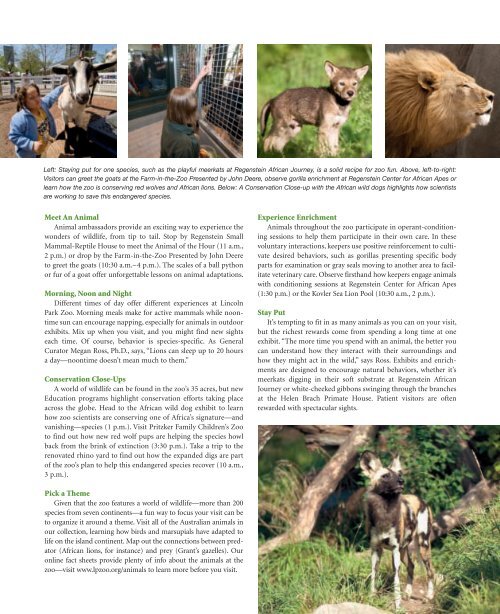Summer Fun at Lincoln Park Zoo
Summer Fun at Lincoln Park Zoo
Summer Fun at Lincoln Park Zoo
Create successful ePaper yourself
Turn your PDF publications into a flip-book with our unique Google optimized e-Paper software.
Left: Staying put for one species, such as the playful meerk<strong>at</strong>s <strong>at</strong> Regenstein African Journey, is a solid recipe for zoo fun. Above, left-to-right:<br />
Visitors can greet the go<strong>at</strong>s <strong>at</strong> the Farm-in-the-<strong>Zoo</strong> Presented by John Deere, observe gorilla enrichment <strong>at</strong> Regenstein Center for African Apes or<br />
learn how the zoo is conserving red wolves and African lions. Below: A Conserv<strong>at</strong>ion Close-up with the African wild dogs highlights how scientists<br />
are working to save this endangered species.<br />
Meet An Animal<br />
Animal ambassadors provide an exciting way to experience the<br />
wonders of wildlife, from tip to tail. Stop by Regenstein Small<br />
Mammal-Reptile House to meet the Animal of the Hour (11 a.m.,<br />
2 p.m.) or drop by the Farm-in-the-<strong>Zoo</strong> Presented by John Deere<br />
to greet the go<strong>at</strong>s (10:30 a.m.–4 p.m.). The scales of a ball python<br />
or fur of a go<strong>at</strong> offer unforgettable lessons on animal adapt<strong>at</strong>ions.<br />
Morning, Noon and Night<br />
Different times of day offer different experiences <strong>at</strong> <strong>Lincoln</strong><br />
<strong>Park</strong> <strong>Zoo</strong>. Morning meals make for active mammals while noontime<br />
sun can encourage napping, especially for animals in outdoor<br />
exhibits. Mix up when you visit, and you might find new sights<br />
each time. Of course, behavior is species-specific. As General<br />
Cur<strong>at</strong>or Megan Ross, Ph.D., says, “Lions can sleep up to 20 hours<br />
a day—noontime doesn’t mean much to them.”<br />
Conserv<strong>at</strong>ion Close-Ups<br />
A world of wildlife can be found in the zoo’s 35 acres, but new<br />
Educ<strong>at</strong>ion programs highlight conserv<strong>at</strong>ion efforts taking place<br />
across the globe. Head to the African wild dog exhibit to learn<br />
how zoo scientists are conserving one of Africa’s sign<strong>at</strong>ure—and<br />
vanishing—species (1 p.m.). Visit Pritzker Family Children’s <strong>Zoo</strong><br />
to find out how new red wolf pups are helping the species howl<br />
back from the brink of extinction (3:30 p.m.). Take a trip to the<br />
renov<strong>at</strong>ed rhino yard to find out how the expanded digs are part<br />
of the zoo’s plan to help this endangered species recover (10 a.m.,<br />
3 p.m.).<br />
Pick a Theme<br />
Given th<strong>at</strong> the zoo fe<strong>at</strong>ures a world of wildlife—more than 200<br />
species from seven continents—a fun way to focus your visit can be<br />
to organize it around a theme. Visit all of the Australian animals in<br />
our collection, learning how birds and marsupials have adapted to<br />
life on the island continent. Map out the connections between pred<strong>at</strong>or<br />
(African lions, for instance) and prey (Grant’s gazelles). Our<br />
online fact sheets provide plenty of info about the animals <strong>at</strong> the<br />
zoo—visit www.lpzoo.org/animals to learn more before you visit.<br />
Experience Enrichment<br />
Animals throughout the zoo particip<strong>at</strong>e in operant-conditioning<br />
sessions to help them particip<strong>at</strong>e in their own care. In these<br />
voluntary interactions, keepers use positive reinforcement to cultiv<strong>at</strong>e<br />
desired behaviors, such as gorillas presenting specific body<br />
parts for examin<strong>at</strong>ion or gray seals moving to another area to facilit<strong>at</strong>e<br />
veterinary care. Observe firsthand how keepers engage animals<br />
with conditioning sessions <strong>at</strong> Regenstein Center for African Apes<br />
(1:30 p.m.) or the Kovler Sea Lion Pool (10:30 a.m., 2 p.m.).<br />
Stay Put<br />
It’s tempting to fit in as many animals as you can on your visit,<br />
but the richest rewards come from spending a long time <strong>at</strong> one<br />
exhibit. “The more time you spend with an animal, the better you<br />
can understand how they interact with their surroundings and<br />
how they might act in the wild,” says Ross. Exhibits and enrichments<br />
are designed to encourage n<strong>at</strong>ural behaviors, whether it’s<br />
meerk<strong>at</strong>s digging in their soft substr<strong>at</strong>e <strong>at</strong> Regenstein African<br />
Journey or white-cheeked gibbons swinging through the branches<br />
<strong>at</strong> the Helen Brach Prim<strong>at</strong>e House. P<strong>at</strong>ient visitors are often<br />
rewarded with spectacular sights.


